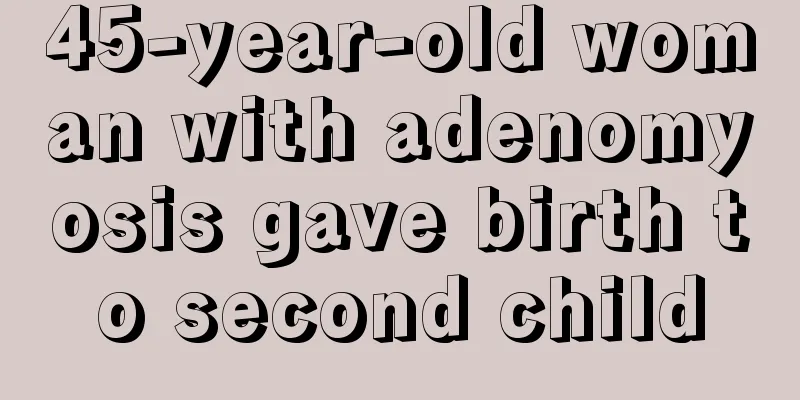45-year-old woman with adenomyosis gave birth to second child

|
Women who are 45 years old have passed the best childbearing age and are considered older mothers. If they suffer from adenomyosis, they should not have a second child, otherwise it may cause some danger. Even if they want to have a second child, they must do so after the disease is cured. This can also reduce the chance of risks. Before that, women should receive the right treatment as soon as possible to cure their adenomyosis. There are many treatment options for this disease, and clinical decisions need to be individualized based on the patient's age, symptoms, and fertility requirements. Surgery and drug treatment options can be chosen at the same time. 1. Medication (1) Symptomatic treatment: For patients with mild symptoms who only require relief of dysmenorrhea, non-steroidal anti-inflammatory drugs such as ibuprofen, indomethacin or naproxen can be used for symptomatic treatment during dysmenorrhea. (2) For patients with mild symptoms, no desire to have children, or near menopause, oral contraceptives or progestins can cause the ectopic endometrium to decidualize and atrophy, thereby controlling the development of adenomyosis. (3) For women with heavy menstrual flow, dysmenorrhea, and no desire to have children, an intrauterine device containing highly effective progestin can be chosen. It continuously releases progestin locally in the uterus to control the development of ectopic lesions and needs to be removed or replaced after five years. (4) Pseudomenopause therapy ("medical oophorectomy" or "medical hypophysectomy") involves the use of drugs to shrink the lesion before surgery and to reduce recurrence after surgery. GnRHa injection makes the hormone level in the body reach the menopausal state, thereby causing the ectopic endometrium to gradually atrophy and play a therapeutic role. The application of GnRHa can significantly reduce the size of the uterus and can be used as a preoperative medication for some patients with larger lesions and difficult surgeries. If you wait until the uterus becomes smaller before performing surgery, the risks and difficulty will be significantly reduced. Side effects may cause menopausal symptoms and even serious cardiovascular and cerebrovascular complications and osteoporosis. Therefore, it is recommended to add estrogen in reverse after 3 months of GnRHa application to alleviate complications. In addition, GnRHa is expensive, so it is not currently used as a long-term treatment option. Once the drug is stopped, the resumption of menstruation may lead to further progression of the disease. |
<<: Middle-aged woman with repeated acne on her face
>>: Ovarian cystic mass is cancer
Recommend
Are breast cysts serious?
Modern women are under increasing pressure in wor...
Can pregnant women drink tea water?
Drinking tea is a common habit for many Chinese p...
How to produce milk quickly after giving birth
After giving birth, the issue that mothers are mo...
Why does a woman have pain on the left side of her abdomen? Causes of pain on the left side of the abdomen
Women often experience symptoms such as abdominal...
Does a cold on the ovulation day affect pregnancy?
Catching a cold during the ovulation period will ...
What fruits can women eat during menstruation?
Every woman has a few days a month when her physi...
The correct steps and methods for removing makeup
Girls usually pay more attention to makeup, becau...
Millet can actually lower blood sugar and prevent type 2 diabetes?
India, China and the United States have the large...
How to calculate ovulation period when menstruation is irregular?
Becoming a mother is not an easy thing. Many peop...
Why do women's private parts become dirtier the more they wash?
Leucorrhea is a discharge from women's vagina...
What are the methods for draining pelvic fluid?
It is necessary to choose an appropriate method t...
What is the reason for a small lump in a woman's groin?
In daily life, the appearance of small bumps in t...
Reasons why pregnant women look bad
We often say that we can tell whether a person is...
Bleeding during intercourse after menopause, beware of cervical cancer!
Menstruation is a normal physiological phenomenon...
Will women's underwear smell after wearing it for a day?
Many people find that their underwear has an odor...









